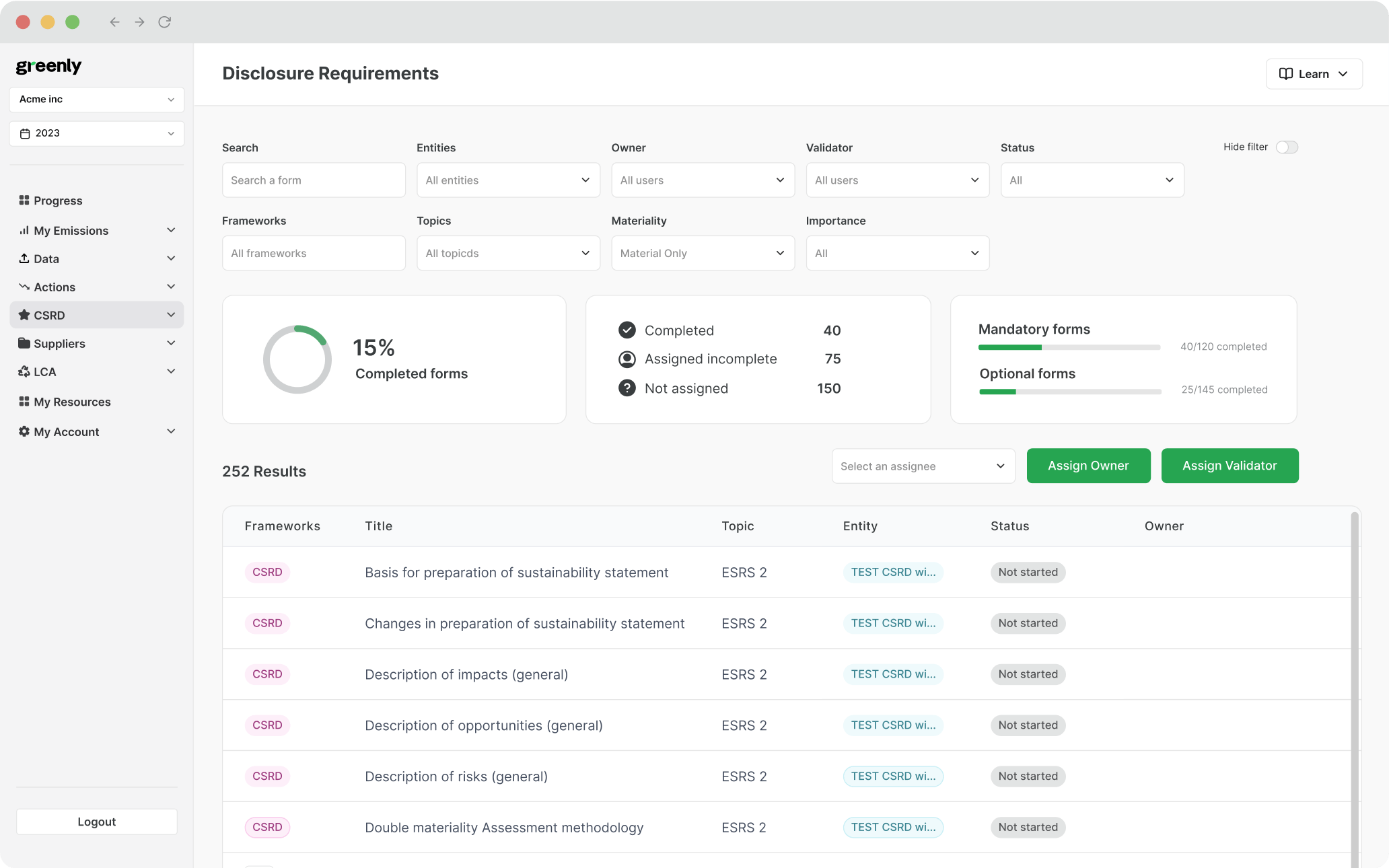
What are the 3 Pillars of Corporate Sustainability?
In this article, we'll explore what the 3 pillars of corporate responsibility are, why they're important, and how businesses can turn them into practical action.
ESG / CSR
Industries



If you can’t measure it, you can’t manage it. That’s especially true when it comes to greenhouse gas (GHG) emissions, and that’s where the Greenhouse Gas Protocol comes in.
Co-created in the late 1990s by the World Resources Institute (WRI) and the World Business Council for Sustainable Development (WBCSD), the protocol emerged just as climate action was gaining international momentum. Today, it’s the foundation of most carbon reporting systems, underpinning CDP disclosures, ESG strategies, and national climate plans alike.
From tracking emissions from company vehicles to mapping the carbon footprint of global supply chains, the GHG Protocol gives organizations a way to turn complex climate impacts into actionable data.
But it’s more than just a reporting tool.
Why does this matter? Because reducing GHG emissions is essential to slowing global warming and avoiding the most dangerous impacts of climate change. But without a reliable way to measure emissions, any reduction target is just guesswork.
That’s where the GHG Protocol plays a vital role. It not only enables organizations to build detailed carbon inventories, it also helps them pinpoint the most impactful areas to cut GHG emissions. And because the standards are internationally recognized, they ensure that efforts are transparent, credible, and comparable across sectors and borders.
Measuring greenhouse gas (GHG) emissions is just the starting point. The GHG Protocol provides the foundation for building effective climate strategies, driving accountability, and turning ambition into real action.
But this is only part of what the GHG Protocol offers. Over the years, it has developed a broader set of standards and tools designed to guide climate action across different sectors and use cases.
In 2019, the GHG Protocol partnered with the Partnership for Carbon Accounting Financials (PCAF) to create a new standard for financial institutions. This helps banks and investors account for the emissions linked to their portfolios – a crucial step in aligning finance with climate goals.
To make reporting easier and more accurate, the protocol also provides:

To build an accurate greenhouse gas inventory, companies need a clear way to categorize their emissions, and that’s where the GHG Protocol scopes come in.


Understanding these scopes is key to setting science-based targets, identifying reduction priorities, and tracking progress over time.
Here’s how the three scopes break down:
| Scope | Definition | Examples |
|---|---|---|
|
🏭 Scope 1
|
Direct GHG emissions from owned or controlled sources. | Fuel used in company vehicles, emissions from on-site boilers or furnaces, process emissions from manufacturing. |
|
💡 Scope 2
|
Indirect GHG emissions from purchased energy. | Emissions from the generation of purchased electricity, heating, cooling, or steam used in company buildings. |
|
🌍 Scope 3
|
All other indirect GHG emissions across the value chain. | Purchased goods and services, business travel, waste disposal, transportation and distribution, product use, and end-of-life. |
The Greenhouse Gas Protocol isn’t a single document, it’s a collection of evolving standards designed to meet the diverse needs of organizations measuring and managing their emissions.
Each standard responds to a specific challenge, whether it’s calculating the impact of a climate policy, understanding the carbon footprint of a supply chain, or designing a lower-emissions product.
Let’s explore the key standards and how they’re used:
The Corporate Standard serves as the foundation for GHG emissions measurement at the organizational level. It outlines how to build a reliable GHG inventory, including how to define organizational and operational boundaries, categorize GHG emissions sources, and ensure data quality over time.
Though primarily designed for companies, it’s also used by government agencies, nonprofits, and academic institutions to ensure consistency and transparency in carbon reporting, especially in high-emissions sectors like manufacturing, transportation, and those reliant on fossil fuels.
According to the Carbon Majors Report, 71% of global emissions since 1988 can be traced back to just 100 companies – underscoring the critical role of corporate accountability in tackling climate change.
Scope 3 emissions (those linked to a company’s supply chain and product use) are often the largest and most difficult to measure.
The Corporate Value Chain Standard, also known as the Scope 3 Standard, helps organizations account for these indirect emissions across 15 defined categories, from purchased goods and employee commuting to product disposal and end-of-life impacts. It enables companies to identify emissions hotspots and make informed decisions about reduction strategies.
This standard is increasingly important as frameworks like CDP and TCFD push for more transparent Scope 3 reporting.
Designed for businesses that want to understand the full climate impact of their products, the Product Standard provides a methodology for calculating GHG emissions from raw material extraction to end-of-life disposal.
By embedding carbon analysis into product design and development, companies can reduce both emissions and costs while responding to growing consumer demand for sustainable products.
When organizations implement climate change mitigation projects, such as renewable energy installations, energy efficiency upgrades, or reforestation, they need a way to credibly quantify those reductions.
The Project Protocol provides a robust approach to assessing the GHG impact of individual projects, allowing for comparison against a baseline or “business as usual” scenario. It’s used by both public and private sector actors to demonstrate climate impact with confidence.
With cities responsible for over 75% of global emissions, local action is vital to addressing climate change. The GPC helps cities, states, and regions measure GHG emissions across sectors like buildings, transport, waste, and industry.
By enabling consistent and comparable data, it supports urban climate planning, helps track progress, and encourages collaboration across local governments.
Many governments have set long-term emissions reduction goals, including Nationally Determined Contributions (NDCs) under the Paris Agreement. The Mitigation Goal Standard helps track progress toward these targets.
It provides a structured approach for evaluating whether policies and actions are delivering the expected results and supports transparent reporting to national and international stakeholders.
When evaluating new climate policies or programs, decision-makers need to understand their likely emissions impact. The GHG Protocol Policy and Action Standard provides a consistent methodology to estimate and compare the effectiveness of different interventions, such as renewable energy subsidies, building codes, or carbon pricing.
It helps policymakers weigh options, improve planning, and communicate expected outcomes to the public and investors.
| Standard | Purpose | Scope / Focus | Who uses it | Key features |
|---|---|---|---|---|
|
🏢 Corporate Standard
|
Develops a complete GHG inventory | Scope 1 & 2 | Companies, NGOs, and public institutions | Defines boundaries, classifies emissions, sets base year, and tracks performance |
|
🔗 Scope 3 Standard
|
Measures emissions across supply chains and product lifecycles | Scope 3 | Corporations and large organizations | Covers 15 categories; focuses on indirect emissions across value chains |
|
📦 Product Standard
|
Assesses emissions of individual products | Product lifecycle | Manufacturers, retailers, and design teams | Informs product development and emissions reduction strategies |
|
🌱 Project Protocol
|
Calculates emissions reductions from specific initiatives | Project-level | Corporations, local authorities, developers | Applies to renewable energy, reforestation, efficiency upgrades, and more |
|
🏙️ GPC for Cities
|
Tracks emissions at the city or regional scale | Community-level | Cities, states, and national governments | Supports local climate planning and benchmarking |
|
🎯 Mitigation Goal Standard
|
Evaluates progress against climate targets | National/regional goals | National and sub-national governments | Designed to align with the Paris Agreement and NDCs |
|
🏛️ Policy and Action Standard
|
Estimates the GHG impact of policy decisions | Government action | Policymakers and regulators | Helps compare options and improve accountability |
For companies looking to future-proof their operations and thrive in a low-carbon economy, the GHG Protocol offers a practical and credible foundation. It offers a clear, consistent framework for measuring and reporting GHG emissions, helping businesses move from ambition to action with data they can trust.
Here’s how the GHG Protocol helps businesses stay ahead:
The GHG Protocol helps organizations understand exactly where their greenhouse gas emissions originate, across Scopes 1, 2, and 3. This enables more focused reduction efforts, whether it’s improving operational efficiency, switching to renewable energy, or redesigning supply chains.
Transparent reporting backed by a globally recognized standard helps companies demonstrate accountability and credibility. In a world where 88% of institutional investors consider ESG factors in their decisions, trust matters more than ever.
The GHG Protocol is embedded in many leading sustainability initiatives, including:
Many ESG frameworks, like CDP and the Science Based Targets initiative, are built on GHG Protocol principles, but companies can also use the GHG Protocol directly to build emissions inventories and set science-based targets.
As governments introduce stricter reporting rules, including requirements for climate-related financial disclosures, companies need a consistent, auditable method for emissions reporting. The GHG Protocol provides exactly that.
By measuring the full emissions impact of their products and services, companies can make more informed design, sourcing, and production decisions, often reducing both emissions and costs. This product-level insight also helps brands meet growing consumer demand for sustainability.


The GHG Protocol is a tool companies can use to drive real greenhouse gas emissions reductions. But knowing where to start and how to apply the standards in practice can be a challenge.
Here’s a practical roadmap to help companies embed the GHG Protocol into their climate strategy:
Start by identifying which GHG Protocol standard (or combination of standards) best fits your company’s goals, size, and emissions profile.
| If your company needs to... | Use this standard |
|---|---|
|
Build a foundational emissions inventory
|
🏢 Corporate Standard |
|
Measure and manage supply chain emissions
|
🔗 Value Chain (Scope 3) Standard |
|
Understand the full carbon footprint of a product
|
📦 Product Standard |
|
Quantify emissions reductions from a specific project
|
🌱 Project Protocol |
|
Track progress against long-term climate targets
|
🎯 Mitigation Goal Standard |
Once the right standard is selected, the next step is to create a robust GHG inventory, the foundation for any climate strategy.
This involves:
With baseline data in place, companies can use their emissions inventory to set short and long-term reduction targets. These targets should align with recognized frameworks like the Science Based Targets initiative (SBTi), which encourages credible and ambitious climate goals.
The GHG Protocol’s structure ensures that targets are based on consistent, transparent emissions data, building internal confidence and external trust.
Once greenhouse gas emissions hotspots are clear, companies can move from measurement to mitigation. Strategies might include:
Tracking progress and reporting results is essential to staying accountable, both internally and externally.
Companies should:
Regular, transparent updates show stakeholders that climate commitments are more than words; they’re backed by action.
Implementing GHG Protocol standards can be complex – from data collection across multiple sites to managing Scope 3 emissions. That’s why many companies rely on carbon management software to simplify reporting and ensure compliance with leading frameworks.
Below are ten popular platforms that help organizations measure, track, and report greenhouse gas emissions.
| Software | Details |
|---|---|
|
1️⃣ Greenly
|
Full carbon management suite, GHG Protocol-aligned reporting, Scope 1–3 tracking, supplier engagement, and lifecycle analysis. Best for: SMEs to large enterprises. |
|
2️⃣ Persefoni
|
Climate management & accounting platform, audit-ready reporting, and ESG data tools. Best for: Large corporations. |
|
3️⃣ Watershed
|
Real-time carbon tracking, science-based targets support, and supply chain decarbonization tools. Best for: Enterprises and financial institutions. |
|
4️⃣ Emitwise
|
Automated emissions calculations with a focus on Scope 3 and supply chain data integration. Best for: Manufacturers and logistics. |
|
5️⃣ Plan A
|
ESG and carbon management platform with automated data collection and sustainability KPIs. Best for: SMEs and corporates. |
|
6️⃣ Normative
|
GHG accounting with spend-based analysis, compliance dashboards, and ESG reporting support. Best for: Mid to large companies. |
|
7️⃣ Carbon Analytics
|
Simplified carbon footprinting with SME-friendly, sector-based reporting templates. Best for: Small businesses. |
|
8️⃣ Enablon (Wolters Kluwer)
|
Enterprise-scale EHS and sustainability reporting, GHG Protocol-aligned. Best for: Large, multinational firms. |
|
9️⃣ FigBytes
|
ESG and sustainability data management platform with GHG reporting and net-zero roadmap tools. Best for: Medium to large companies. |
|
🔟 Sustain.Life
|
Easy-to-use emissions tracking, climate disclosures, and employee engagement features. Best for: SMEs and start-ups. |
The Greenhouse Gas Protocol is widely recognized as the leading framework for US companies to measure and report emissions in line with federal regulations, SEC climate disclosure rules, and corporate net-zero commitments.
A: The Greenhouse Gas Protocol (GHG Protocol) is the world’s most widely used standard for greenhouse gas reporting. It provides a framework for companies, governments, and organizations to measure and manage emissions consistently across operations and supply chains.
A: While both are used for carbon accounting, the GHG Protocol is more widely adopted globally and underpins many ESG frameworks (CDP, SBTi, CSRD). ISO 14064 is a technical standard often used for verification and auditing purposes.
A: Carbon management platforms like Greenly, Persefoni, and Watershed automate Scope 1–3 calculations, streamline data collection, and provide audit-ready, GHG Protocol-aligned reports.
A: Start by selecting the right standard, building a Scope 1–3 emissions inventory, setting science-based targets, and implementing reduction initiatives. Many businesses use software to simplify data tracking and reporting.
A: While not legally mandated itself, the GHG Protocol is widely used in federal and state-level climate reporting, supports EPA emissions programs, and is expected to play a central role in upcoming SEC climate disclosure requirements. It also underpins ESG frameworks like CDP, TCFD, and ISSB, making it essential for companies working toward US net-zero goals.
Navigating the complexities of GHG accounting and emissions management can be challenging, but that's where Greenly comes in. Our carbon management services are designed to help your company measure, analyze, and reduce emissions effectively, aligning with global frameworks like the Greenhouse Gas Protocol.
Here's how we can support your sustainability journey:
| Service | Details |
|---|---|
|
Emissions Tracking
|
Our platform allows you to monitor Scope 1, 2, and 3 emissions, helping you identify hotspots and target reduction strategies with precision. |
|
Lifecycle Assessments (LCAs)
|
Gain detailed insights into the environmental impact of your products and services, empowering you to make data-driven decisions for improvement. |
|
Supply Chain Sustainability
|
We provide tailored guidance to help you engage with suppliers and transition to more sustainable practices across your value chain. |
|
Science-Based Target Setting
|
Our team supports you in setting achievable science-based targets that align with your company's goals and international standards like the SBTi. |
|
Decarbonization Pathways
|
Create actionable roadmaps to reduce emissions, optimize operations, and enhance efficiency. |
|
Regulatory Compliance
|
Stay ahead of evolving regulations with our tools and insights that simplify compliance with ESG frameworks like GRI, SASB, and others. |
|
Tailored Action Plans
|
Our industry-specific recommendations help you focus on practical, impactful steps to achieve your sustainability targets. |
|
User-Friendly Reporting Tools
|
Simplify emissions reporting for stakeholders and regulators with Greenly's intuitive dashboards and reports. |
Whether you're just starting your carbon management journey or looking to refine your strategy, Greenly's expertise and solutions can help your company make meaningful progress toward a more sustainable future. Get in touch with Greenly today to find out more.
